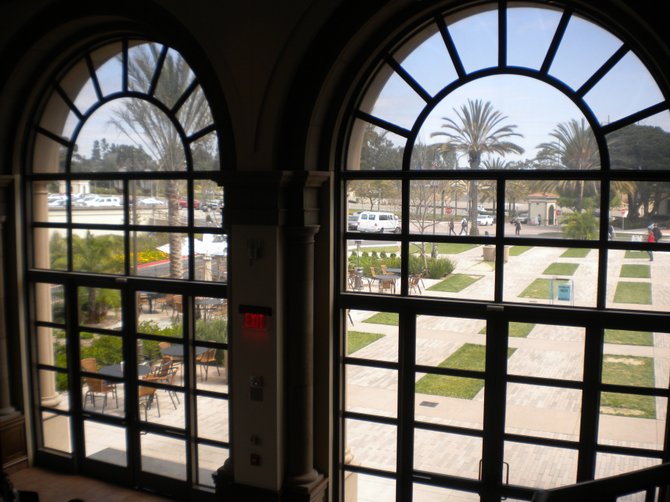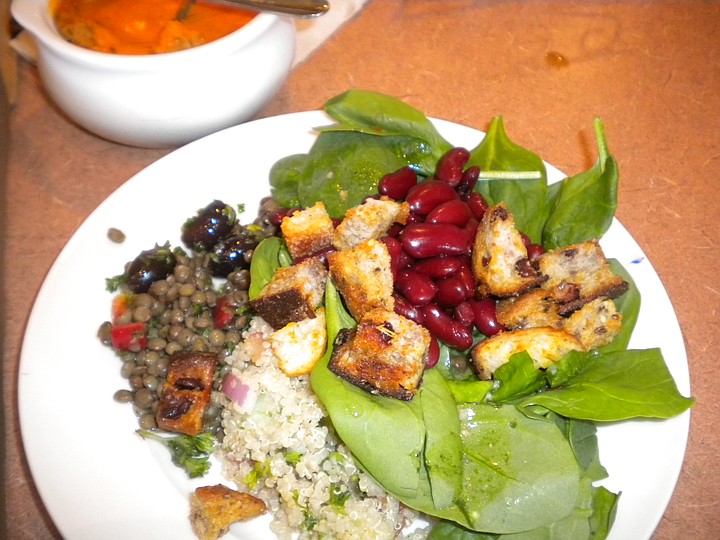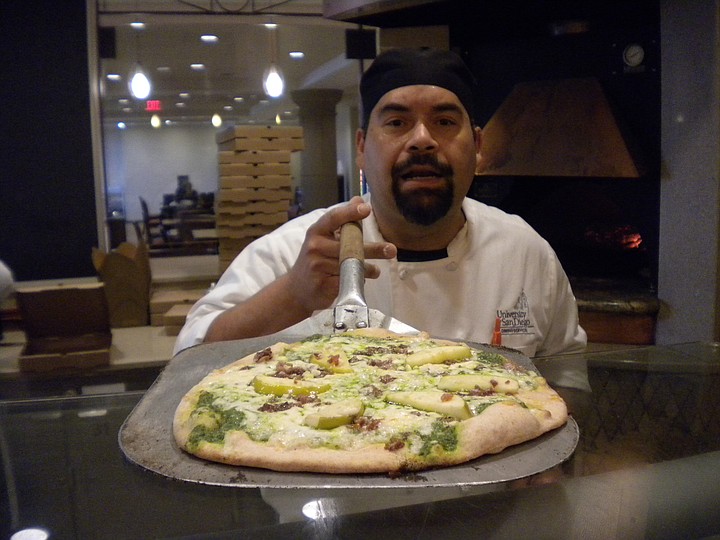 Facebook
Facebook
 X
X
 Instagram
Instagram
 TikTok
TikTok
 Youtube
Youtube

“Got three minutes?”
Mickey Gonzalez is lookin’ at me, and you just know he’s from back East ’cause he speaks in that big “You talkin’ to me?” voice.
“I’ve got a fresh one in the oven right now,” he says. “Trust me, this one has gone dry. Nothing worse than dried-out pizza.” He picks the last third of a pepperoni pizza up and is about to throw it off its tray into the waste bin.
“I’ll take that,” says the student standing next to me. “I don’t have three minutes.”
“Ho-kay.” Mickey holds the pizza like it’s a piece of road kill. “Your choice.”
Seems like fresh is everything to Mickey. He was brought up in Hoboken, half a block away from the house Frank Sinatra grew up in. In Hoboken, a pizza ain’t a pizza, it’s a pie. “Back home,” says Mickey, “they’re very particular. What you gonna have?”
This is happening inside the way-big eating complex they call Pavilion Dining, part of the Student Life Pavilion of the University of San Diego. Ten minutes ago, I got off the 44 bus on Linda Vista Road outside Marian Way. That’s the main artery through the hilltop cluster of the school’s halls. Looks like the Prado in Balboa Park. Very romantic, very Spanish.
I wanted to see if they still had good cheap lunches for outsiders here.
But, my, how it’s changed. Last time I was on campus, this space was a parking lot. Now it’s this magnificent new-but-old-looking Student Life Pavilion. I hiked across sculpted gardens and into this eating area with a terrace of tables and chairs outside massive windows. It has two-story-high ceilings, massive round stone columns, tile floors, and black curly-iron grille work. Kinda Santa Fe Depot meets the temples at Karnak in Egypt. Makes everybody chowing at the tables look small.
Mickey tells me the whole thing was finished almost two years ago. “And, hey, the CIA helped them get their food operation up and running.”
CIA? Don’t worry — we’re talkin’ Culinary Institute of America, folks. The new center, Mickey says, has launched “a renaissance here, foodwise.”

We’re yakkin’ in the serving area, abuzz with a dozen eateries selling different kinds of food. Pretty impressive for a student caf. I spot stations offering beef or salmon steaks (“Tapenade”), Vietnamese (“Lemon Grass”), Mexican (“Maiz”), burgers (“Sea Salt Grill”), sushi (“Nori Now”), Chinese wok cooking (“Mu Shu”), two salad bars (“Chives”), a soup station (“Bay Leaf”), Mickey’s pizza counter (“Heirloom Cucina”), and something they call “Secret Ingredient,” which is a “live-action cooking station,” where you find out what the day’s dish is by going on Twitter or visiting usd.webfood.com at midday (or 5:00 p.m. for dinner). Or, like, turning up. (Duh.)
Prices for most things are reasonable, but for students, I’m guessing, not the cheapest. We’re talking eight, nine, ten bucks for average dishes. Nori Now’s special today (“Tilapia, tempura shrimp, crab, wasabi Tobika, cucumber, ginger, Yuzu mayo”) costs $10.95. Big chunk out of any student’s meal plan. But things like salads are sold by weight, so it depends how greedy or starving you are. Actually, they’ve devised a great way of keeping you from eating too much: they have no trays. You only get what you can carry to the checkout with your two hands.
Me, I stop at the pizza place because there’s Mr. Mickey, larger than life, explaining, taking orders, laughing, joking, working pizza paddles, and throwing his pies into what looks like a wood-burning oven. Quite a show. I’m impressed that he’s a freshness fanatic. The pizzas are a good price: mostly $6.95. Plus, they have calzones and something called piadines. I see this guy next to me picking up one. It looks like flatbread with a pile of lettuce on top.
“I sell three piadines for every pizza I make,” Mickey says. Turns out these are an ancient dish. This kind of bread came from Byzantium, via Italy — basically, it’s flour and water. What Mickey does is stick it in the pizza oven, then splots a salad on top — Mediterranean, Caesar, Caprese, or steak. It costs $6.95 without meat; $7.25 with.

I’m drawn to the look of the Vespa pizza, which is pesto, mozzarella, bacon, and slices of apple. It’s $6.95. I order that. While Mickey’s squirting green pesto on the raw dough, then flinging the shredded mozzarella about and planting apple slices on top and sliding it all into the fire, I make off to “Chives,” the salad-bar area. I load up on quinoa, dark lentils with Kalamata olives, some red beans, spinach leaves, and croutons. I can’t resist filling a bowl with “Broadway basil and tomato bisque” (I could have had organic vegetarian chili soup or hearty beef and barley). By this time, Mickey’s hauling out that nine-inch green ’n’ cream pizza and sticking it in a box. At the checkout, Courtney charges me $3.50 for the soup, $6.95 for the pizza, and $3.84 for the salad. I get a small coffee ($1.45). So — whack! — the whole lot costs me $17.12, with tax, wildly over what I meant to spend. But the soup is fab; the basil makes it interesting. The pizza is light and thin and crispy and sweet (apple) and salty (bacon). And, Mickey says, healthy. “We use wheat — not ordinary white flour — and part-skim-milk mozzarella, to make it lighter.”
Fact is, I haul most of the pizza home.
“What do you think?” I ask Carla.
She’s already crunching in. She looks up, mouth full.
“You talkin’ to me?” ■
The Place: Heirloom Cucina at the Student Life Pavilion, USD, 5998 Alcalá Park, 619-260-4600
Type of Food: American, ethnic
Prices: Pizzas, e.g. the Vespa (with pesto, mozzarella, bacon, slices of apple), $6.95; calzones (around $7 each, different flavors); piadines, (flatbread with salads, e.g. Mediterranean, Caesar, Caprese, steak, piled on top, 6.95 without meat, $7.25 with; soups (e.g. basil and tomato bisque, vegetarian chili, beef and barley), $3.50; salads by weight, average $3.50; many ethnic food stations
Hours: Breakfast 7:30 a.m.–10:00 a.m.; lunch 11:00 a.m.–3:00 p.m.; dinner 4:30–9:00 p.m.; weekend brunch 10:00 a.m.–2:00 p.m.
Bus: 44
Nearest Bus Stop: Linda Vista Road, Santa Ana Drive


“Got three minutes?”
Mickey Gonzalez is lookin’ at me, and you just know he’s from back East ’cause he speaks in that big “You talkin’ to me?” voice.
“I’ve got a fresh one in the oven right now,” he says. “Trust me, this one has gone dry. Nothing worse than dried-out pizza.” He picks the last third of a pepperoni pizza up and is about to throw it off its tray into the waste bin.
“I’ll take that,” says the student standing next to me. “I don’t have three minutes.”
“Ho-kay.” Mickey holds the pizza like it’s a piece of road kill. “Your choice.”
Seems like fresh is everything to Mickey. He was brought up in Hoboken, half a block away from the house Frank Sinatra grew up in. In Hoboken, a pizza ain’t a pizza, it’s a pie. “Back home,” says Mickey, “they’re very particular. What you gonna have?”
This is happening inside the way-big eating complex they call Pavilion Dining, part of the Student Life Pavilion of the University of San Diego. Ten minutes ago, I got off the 44 bus on Linda Vista Road outside Marian Way. That’s the main artery through the hilltop cluster of the school’s halls. Looks like the Prado in Balboa Park. Very romantic, very Spanish.
I wanted to see if they still had good cheap lunches for outsiders here.
But, my, how it’s changed. Last time I was on campus, this space was a parking lot. Now it’s this magnificent new-but-old-looking Student Life Pavilion. I hiked across sculpted gardens and into this eating area with a terrace of tables and chairs outside massive windows. It has two-story-high ceilings, massive round stone columns, tile floors, and black curly-iron grille work. Kinda Santa Fe Depot meets the temples at Karnak in Egypt. Makes everybody chowing at the tables look small.
Mickey tells me the whole thing was finished almost two years ago. “And, hey, the CIA helped them get their food operation up and running.”
CIA? Don’t worry — we’re talkin’ Culinary Institute of America, folks. The new center, Mickey says, has launched “a renaissance here, foodwise.”

We’re yakkin’ in the serving area, abuzz with a dozen eateries selling different kinds of food. Pretty impressive for a student caf. I spot stations offering beef or salmon steaks (“Tapenade”), Vietnamese (“Lemon Grass”), Mexican (“Maiz”), burgers (“Sea Salt Grill”), sushi (“Nori Now”), Chinese wok cooking (“Mu Shu”), two salad bars (“Chives”), a soup station (“Bay Leaf”), Mickey’s pizza counter (“Heirloom Cucina”), and something they call “Secret Ingredient,” which is a “live-action cooking station,” where you find out what the day’s dish is by going on Twitter or visiting usd.webfood.com at midday (or 5:00 p.m. for dinner). Or, like, turning up. (Duh.)
Prices for most things are reasonable, but for students, I’m guessing, not the cheapest. We’re talking eight, nine, ten bucks for average dishes. Nori Now’s special today (“Tilapia, tempura shrimp, crab, wasabi Tobika, cucumber, ginger, Yuzu mayo”) costs $10.95. Big chunk out of any student’s meal plan. But things like salads are sold by weight, so it depends how greedy or starving you are. Actually, they’ve devised a great way of keeping you from eating too much: they have no trays. You only get what you can carry to the checkout with your two hands.
Me, I stop at the pizza place because there’s Mr. Mickey, larger than life, explaining, taking orders, laughing, joking, working pizza paddles, and throwing his pies into what looks like a wood-burning oven. Quite a show. I’m impressed that he’s a freshness fanatic. The pizzas are a good price: mostly $6.95. Plus, they have calzones and something called piadines. I see this guy next to me picking up one. It looks like flatbread with a pile of lettuce on top.
“I sell three piadines for every pizza I make,” Mickey says. Turns out these are an ancient dish. This kind of bread came from Byzantium, via Italy — basically, it’s flour and water. What Mickey does is stick it in the pizza oven, then splots a salad on top — Mediterranean, Caesar, Caprese, or steak. It costs $6.95 without meat; $7.25 with.

I’m drawn to the look of the Vespa pizza, which is pesto, mozzarella, bacon, and slices of apple. It’s $6.95. I order that. While Mickey’s squirting green pesto on the raw dough, then flinging the shredded mozzarella about and planting apple slices on top and sliding it all into the fire, I make off to “Chives,” the salad-bar area. I load up on quinoa, dark lentils with Kalamata olives, some red beans, spinach leaves, and croutons. I can’t resist filling a bowl with “Broadway basil and tomato bisque” (I could have had organic vegetarian chili soup or hearty beef and barley). By this time, Mickey’s hauling out that nine-inch green ’n’ cream pizza and sticking it in a box. At the checkout, Courtney charges me $3.50 for the soup, $6.95 for the pizza, and $3.84 for the salad. I get a small coffee ($1.45). So — whack! — the whole lot costs me $17.12, with tax, wildly over what I meant to spend. But the soup is fab; the basil makes it interesting. The pizza is light and thin and crispy and sweet (apple) and salty (bacon). And, Mickey says, healthy. “We use wheat — not ordinary white flour — and part-skim-milk mozzarella, to make it lighter.”
Fact is, I haul most of the pizza home.
“What do you think?” I ask Carla.
She’s already crunching in. She looks up, mouth full.
“You talkin’ to me?” ■
The Place: Heirloom Cucina at the Student Life Pavilion, USD, 5998 Alcalá Park, 619-260-4600
Type of Food: American, ethnic
Prices: Pizzas, e.g. the Vespa (with pesto, mozzarella, bacon, slices of apple), $6.95; calzones (around $7 each, different flavors); piadines, (flatbread with salads, e.g. Mediterranean, Caesar, Caprese, steak, piled on top, 6.95 without meat, $7.25 with; soups (e.g. basil and tomato bisque, vegetarian chili, beef and barley), $3.50; salads by weight, average $3.50; many ethnic food stations
Hours: Breakfast 7:30 a.m.–10:00 a.m.; lunch 11:00 a.m.–3:00 p.m.; dinner 4:30–9:00 p.m.; weekend brunch 10:00 a.m.–2:00 p.m.
Bus: 44
Nearest Bus Stop: Linda Vista Road, Santa Ana Drive